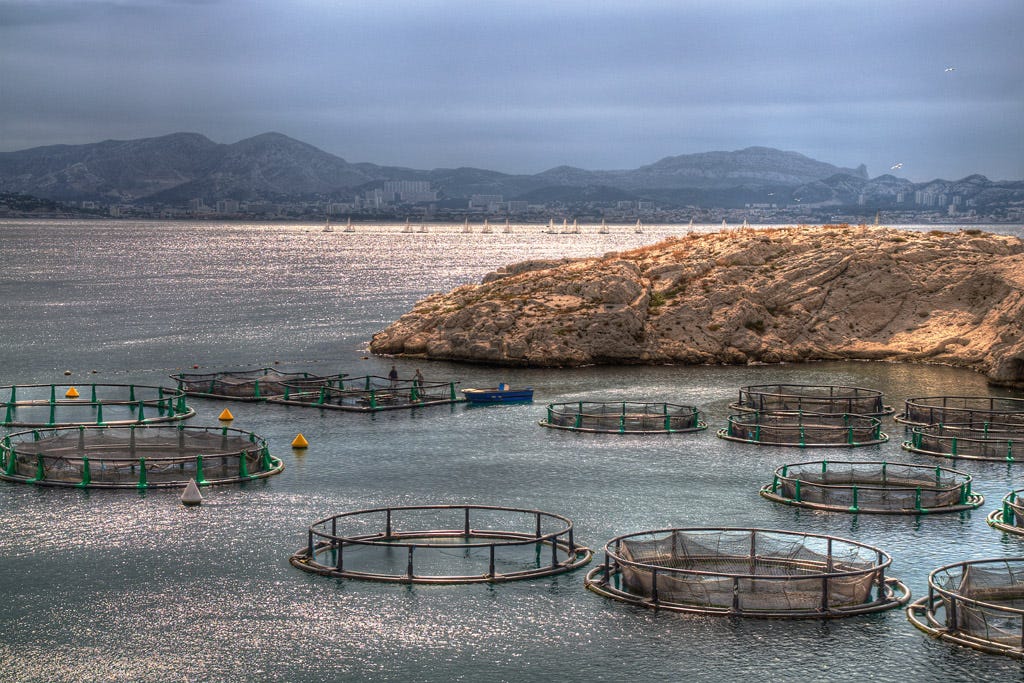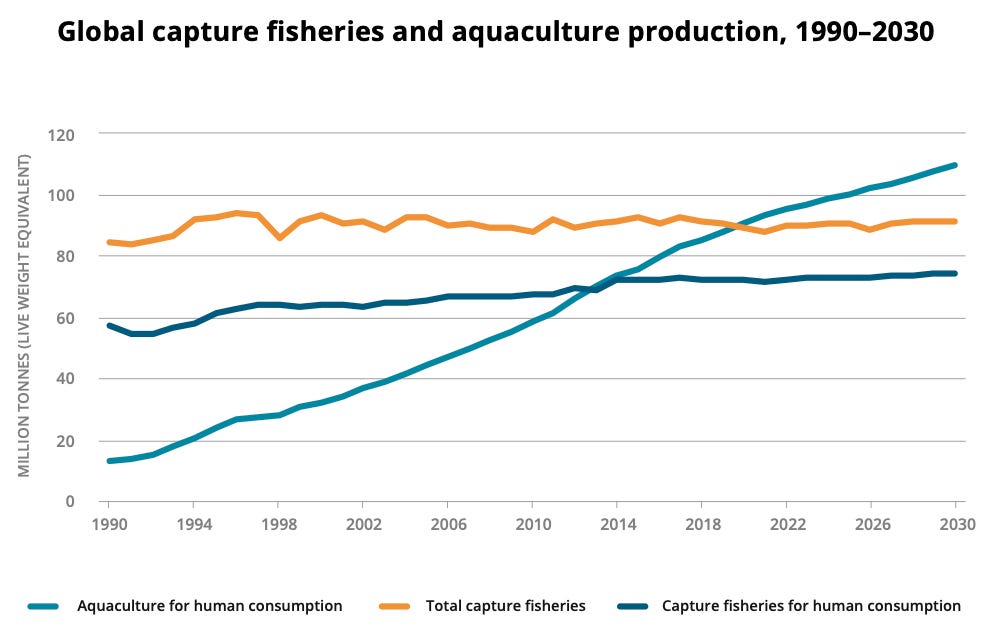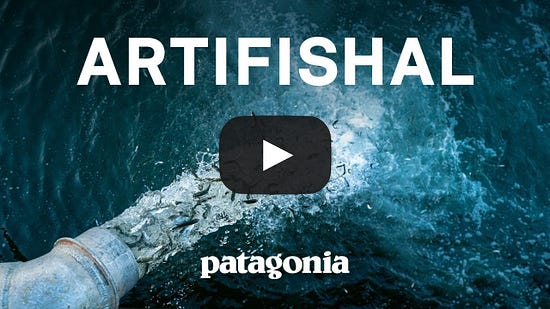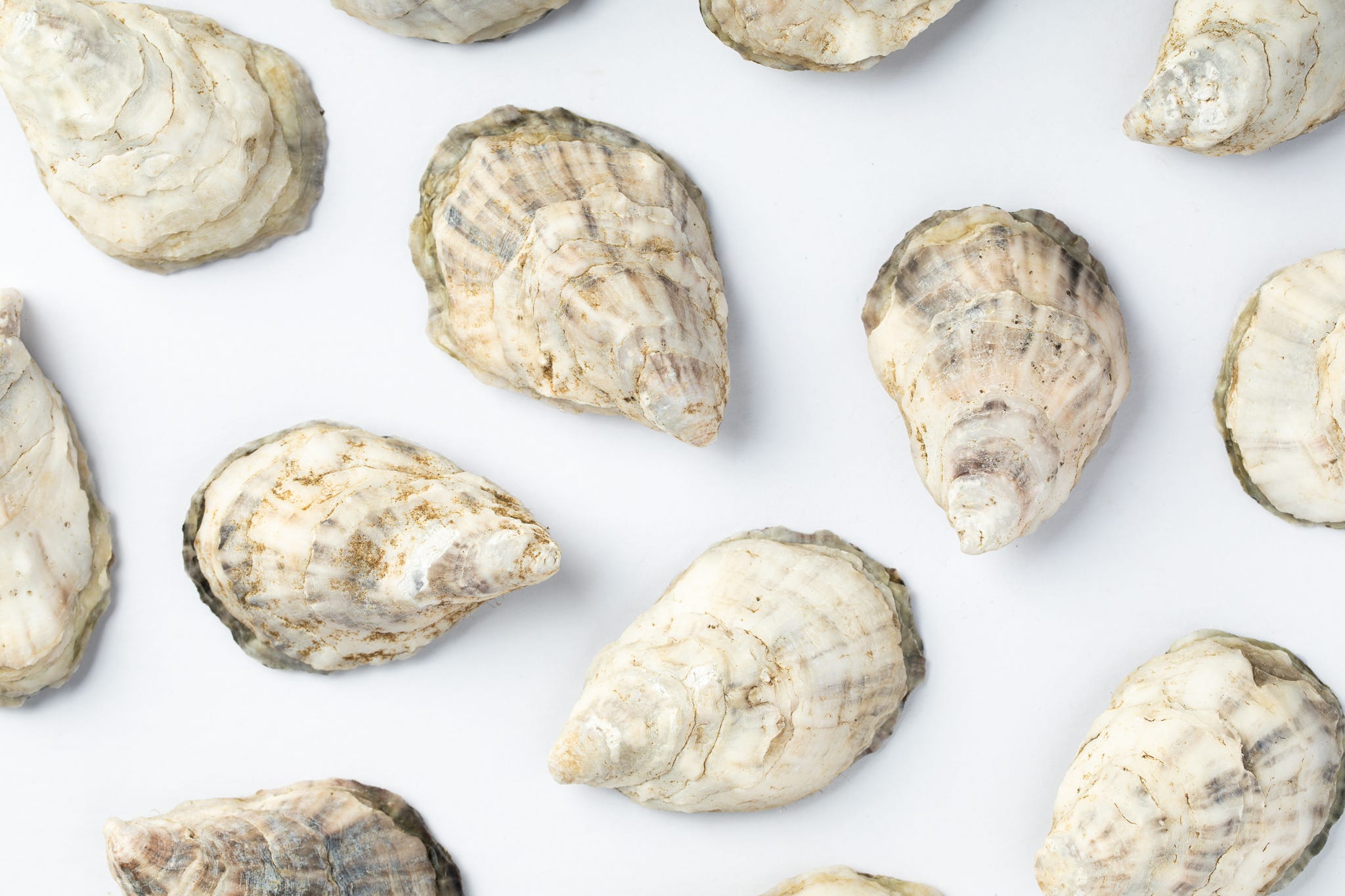The Rise of Aquaculture and the Threat of Floating Feedlots

Aquaculture was once thought to be the key to saving wild fish stocks. As discussed in the article below, it turns out to be fraught with unintended consequences.
NOTE: this post was originally sent by email by The Regeneration Weekly on June 13, 2021. It was written by Parker Hughes.
Health: Since the 1960s, the average annual increase in global fish consumption (3.2 percent) has outpaced population growth (1.6 percent) and exceeded the combined consumption of meat from all terrestrial animals (2.8 percent). In per capita terms, global fish consumption has more than doubled from 9.0 kg (19.84 lbs) in 1961 to 20.5 kg (45.19 lbs) in 2017. And according to the Food and Agriculture Organization of the United Nations, this figure is expected to swell to 21.5 kg (47.39) by 2030 due to growing populations and incomes. Of course, fishing is not inherently bad for the ocean, except for when ships catch fish faster than stocks can replenish, referred to as overfishing. But as it stands, around 90 percent of the world’s fish stocks are now fully exploited or overfished. And since the 1990s, the global catch of wild fish has either plateaued or declined year-over-year. Thus, the majority of the seafood supply is expected to come from industrial ocean fish farming, also called aquaculture. In fact, in 2021, fish farming is forecasted to overtake wild-caught fish production for the first time.
In short, aquaculture is the mass breeding, rearing, and harvesting of fish in areas of the ocean. While this technique offers an alternative to overfishing wild species, it’s far from a perfect system. The most common form of aquaculture takes place in open-net pens, or cages, suspended from structures anchored to the seafloor. These floating feedlots, holding hundreds of thousands of fast-growing fish breeds (i.e., carp, salmon, tilapia) at a time, are considered a high-risk production system – posing significant harm to the environment, and the people, industries, and economies that rely on the ocean and its resources. Similar to industrial animal agriculture, corporations are taking over our oceans. In 2015, 13 companies controlled up to 16 percent of the global marine catch and 40 percent of the largest and most valuable fish stocks. In doing so, modern fish farms strive to consolidate seafood production and create economies of scale while externalizing the costs (ecological or public health) of production to society as a whole. The problems generated by open-net pens include but are not limited to:
Disease: Like any feedlot system, diseases – including sea lice and infectious salmon anemia – spread across aquaculture farms given the close proximity of bodies, as well as chronic stress, which can depress fish immune systems. And because open-net pens are often located offshore in coastal areas, when outbreaks do occur, they pose risks to the wild fish populations. Farmed Atlantic salmon, for example, infect wild Chinook salmon in British Columbia with Piscine orthoreovirus, associated with kidney and liver damage. Rather than solve the root of the problem, fish farms compound the issue by overusing pesticides and agrochemicals to prophylactically prevent illness. With this in mind, it is no surprise that there is now an increased presence ofantimicrobial resistance in farmed fish due to the overuse of antibiotics. And on average, farmed salmon contains 16 times more dioxin-like polychlorinated biphenyls (PCBs) than wild salmon. These highly toxic compounds not only leave residues in our seafood, but they also sink into the ocean floor, contaminating nearby water and decreasing biodiversity.
Pollution: Net-pen aquaculture is essentially an underwater factory farm but with even fewer pollution controls. The systems allow for free exchange between the “farm” and the open water, including direct deposits of untreated fecal waste and agrochemical drug residues. At many facilities, excess feed and thousands of gallons of fish waste – mostly blood, often carrying parasites and viruses – are channeled directly into the surrounding ocean ecosystem. According to the Environmental Protection Agency, an industrial fish farm of 200,000 salmon will release nitrogen equivalent to the untreated sewage of 20,000 people, phosphorus equivalent to 27,000 people, and fecal matter equivalent to 62,500 people. When these excess nutrients are added to water, eutrophication occurs. Water becomes too enriched, causing low dissolved oxygen levels, death of seagrasses and corals, fish kills, “dead zones,” and harmful algal blooms.
Invasive species: Open-net pens have a rocky history of failure, resulting in large-scale escape events, or as “leakage” (continual low-level escapes over the farm cycle), of non-native fishes into the ocean. In 2016, Cooke Aquaculture’s Cypress Island facility in northern Puget Sound imploded – allowing more than 260,000 non-native Atlantic salmon to escape. Farmed fish, which are genetically bred to grow bigger and faster, are also a significant concern to the gene pool of wild fish populations. The consequence of inbreeding between farmed and wild Atlantic salmon results in genetic diversity dilution, generational fitness degradation, and adaptation loss. Escapees can also compete with wild fish for limited food, spawning habitat, and other resources.
Feed production: Rather than remove the strain on wild fish populations, industrial aquaculture contributes to the overfishing of wild species. Many farmed species, such as shrimp and finfish (salmon, trout, Arctic char, cod, and tuna) are predators who rely on a carnivorous diet. To meet the protein needs of their stocks, fish farmers rely on “fish meal,” which combines fish oil from smaller, wildforage fish (anchovy, herring, and krill), genetically modified (GMO) soybeans, chemicals, and dyes into feed pellets. Every year, almost 4 million hectares of forest in South America are converted to cropland to grow the soybeans used in fish meal. And 30 million tons of forage fish are caught and processed annually to feed farmed fish, thereby putting pressure on wild fish populations and impacting other wildlife that depends on them for food. This processed diet also equates to farmed salmon containing 20.5 percent more saturated fat and fewer vitamins and minerals (potassium, zinc, and calcium) than wild salmon.
To help usher in a more sustainable ocean economy, the Canadian government recently elected to phase out all of the open-net pen salmon farms in British Columbia by June of 2022. At the same time, thriving runs, or “stocks,” of wild salmon still exist, and a return to selective-fishing techniques can make a positive impact on their populations. Place-based fisheries, for example, operate with the knowledge that every stock of wild salmon evolved to return to specific watersheds. And unlike industrial salmon harvests, which happen on the open ocean, this method is conducted in or near rivers of origin. In doing so, fishermen can responsibly target wild salmon populations while minimizing harm to less plentiful stocks. At the same time, nonprofits like the Wild Fish Conservancy (WFC) and the Native Fish Society are working to protect and restore wild fish populations and the ecosystems they depend on through education and advocacy. If we really care about preserving fish stocks and freshwater ecosystems for decades to come, we must focus on harvesting wild fish in the right numbers, from the right places, rather than creating more aquatic feedlots.
Watch: Artifishal is a documentary about people, rivers, and the fight for the future of wild fish and the environment that supports them. This movie, produced by Patagonia Films, explores wild salmon’s precipitous slide toward extinction, the threats posed by fish hatcheries and fish farms, and the path to recovery.
Shop: Running Tide is a building technology that harnesses the power of the ocean to rebuild food systems that are zero carbon and provide positive ecosystem services. Their coastal shellfish reefs, kelp forests, and seagrass meadows are engines for biodiversity and job creation. A lot of love goes into Running Tide’s beautiful oysters, which are cultivated from their own hatchery and then placed in hand-picked grow-out areas in Casco Bay. As they grow, they take on the sweet flavor of Maine’s pristine waters. And to protect and better understand the ocean environment, Running Tide donates 2 percent of its annual revenue to support ongoing marine research. Click here to shop their line regenerative oysters.





